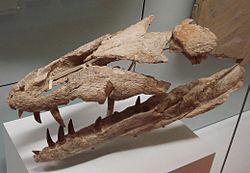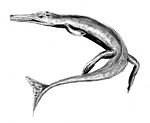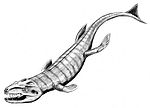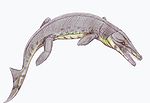- Metriorhynchidae
-
Metriorhynchidae
Temporal range: Middle Jurassic-Early Cretaceous, 170–135 MaDakosaurus maximus skull, Staatliches Museum für Naturkunde Stuttgart Scientific classification 
Kingdom: Animalia Phylum: Chordata Class: Reptilia Superorder: Crocodylomorpha Suborder: †Thalattosuchia Superfamily: †Metriorhynchoidea Family: †Metriorhynchidae
Fitzinger, 1843subfamily Synonyms Metriorhynchidae is an extinct family of metriorhynchoid crocodyliforms from the Middle Jurassic to the Early Cretaceous period (Bajocian - Valanginian stages) of Europe, North America and South America. Metriorhynchids are fully aquatic crocodyliforms. Their forelimbs were small and paddle-like, and unlike living crocodilians, they lost their osteoderms ("armour scutes"). Their body shape maximised hydrodynamy (swimming efficiency), as did having a shark-like tail fin.[2]
Metriorhynchids were the only group of archosaurs to become fully adapted to the marine realm, becoming pelagic in lifestyle.[3]
The name Metriorhynchidae was coined by the Austrian zoologist Leopold Fitzinger in 1843.[4] It contains two subfamilies, the Metriorhynchinae and the Geosaurinae.[5][6]
Contents
Geographical distribution
The family has a wide geographic distribution, with material found in Argentina, Chile, Cuba, England, France, Germany, Italy, Mexico, Poland, Russia and Switzerland.[6][3]
Classification
Phylogenetic analyses published during the 2000s cast doubt on the idea that many traditional metriorhynchid genera formed natural groups (i.e., include all descendants of a common ancestor). The traditional species of Geosaurus,[7][8][9] Dakosaurus[7] and Cricosaurus[7] were found to represent unnatural groups, and the species traditionally classified in these genera were reshuffled in a study published in November 2009 by Mark T. Young and Marco Brandalise de Andrade.[5] The monophyly of Metriorhynchus [7][8][10] and Teleidosaurus[7][9] is also unsupported, and the species of these genera are pending reclassification.[5]
The classification presented by Young and Andrade in 2009 was approved in later studies of the Metriorhynchidae.[11][6][12] Metriorhynchidae is a node-based taxon defined in 2009 as the least inclusive clade consisting of Metriorhynchus geoffroyii and Geosaurus giganteus.[5] The cladogram below follows the topology from a 2011 analysis by Andrea Cau and Federico Fanti with clade names from Young et al. 2011 and reduced to genera only.[11][6]
Metriorhynchidae Metriorhynchinae Rhacheosaurini Rhacheosaurus
Metriorhynchinae indet. (USNM 19640)
Gracilineustes
Geosaurinae Suchodus
Geosaurinae indet. (="Metriorhynchus" aff. "M." brachyrhynchus)
Geosaurini Torvoneustes
List of genera
The type genus of the family Metriorhynchidae is Metriorhynchus from the Middle to Late Jurassic.[3] Other genera included within this family are Cricosaurus, Geosaurus, and Dakosaurus. Though once considered a metriorhynchid, Teleidosaurus has since been found to be slightly more distantly related to these animals within the superfamily Metriorhynchoidea.
Within this family, the genus Neustosaurus is considered nomen dubium ("doubtful name").[13]
The genus Capelliniosuchus was once thought to be a metriorhynchid similar to Dakosaurus.[14] However, Sirotti demonstrated that it is a junior synonym of Mosasaurus.[15]
Genus Status Author Age Location Description Synonyms Images Valid Wagner, 1858 middle Oxfordian to upper Valanginian Argentina, Chile, Cuba, England, France, Germany, Mexico, Russia and Switzerland.
- Enaliosuchus[16]
Valid von Quenstedt, 1856 lower Oxfordian to lower Berriasian Argentina, England, France, Germany, Mexico, Poland, Switzerland and possibly Russia.
- Aggiosaurus
- Dacosaurus (lapsus calami)
Valid Cuvier, 1824 upper Kimmeridgian to upper Valanginian France, Germany, Italy and Switzerland.
- Brachytaenius
- Halilimnosaurus
- Gracilineustes[19]
Valid Young et al., 2010 lower Kimmeridgian France (Normandy)
Valid von Meyer, 1830 lower Callovian to upper Kimmeridgian. England, France, Germany and Switzerland.
- Metiorychus (lapsus calami)
Valid Cau & Fanti, 2011 late Bajocian to earliest Bathonian Italy
nomen dubium — potential senior synonym of Cricosaurus Valid Rusconi, 1948 lower Callovian to lower Tithonian Argentina and Chile.
- Rhacheosaurus
Valid von Meyer, 1831 lower Tithonian Germany
- Suchodus
Valid Lydekker, 1890 lower Callovian to lower Oxfordian England and France.
- Torvoneustes[22]
Valid Andrade et al., 2010 upper Kimmeridgian England
See also
References
- ^ Andrews CW. 1913. A descriptive catalogue of the marine reptiles of the Oxford Clay, Part Two. London: British Museum (Natural History), 206 pp.
- ^ Fraas E. 1902. Die Meer-Krocodilier (Thalattosuchia) des oberen Jura unter specieller Berücksichtigung von Dacosaurus und Geosaurus. Paleontographica 49: 1-72.
- ^ a b c Steel R. 1973. Crocodylia. Handbuch der Paläoherpetologie, Teil 16. Stuttgart: Gustav Fischer Verlag,116 pp.
- ^ Fitzinger LJFJ. 1843. Systema Reptilium. Wien: Braumüller et Seidel, 106 pp.
- ^ a b c d Mark T. Young and Marco Brandalise de Andrade (2009). "What is Geosaurus? Redescription of Geosaurus giganteus (Thalattosuchia: Metriorhynchidae) from the Upper Jurassic of Bayern, Germany". Zoological Journal of the Linnean Society 157 (3): 551–585. doi:10.1111/j.1096-3642.2009.00536.x.
- ^ a b c d Mark T. Young, Stephen L. Brusatte, Marcello Ruta and Marco Brandalise de Andrade (2010). "The evolution of Metriorhynchoidea (Mesoeucrocodylia, Thalattosuchia): an integrated approach using geometrics morphometrics, analysis of disparity and biomechanics". Zoological Journal of the Linnean Society 158 (4): 801–859. doi:10.1111/j.1096-3642.2009.00571.x.
- ^ a b c d e Young MT. 2007. The evolution and interrelationships of Metriorhynchidae (Crocodyliformes, Thalattosuchia). Journal of Vertebrate Paleontology 27 (3): 170A.
- ^ a b Wilkinson LE, Young MT, Benton MJ. 2008. A new metriorhynchid crocodilian (Mesoeucrocodylia: Thalattosuchia) from the Kimmeridgian (Upper Jurassic) of Wiltshire, UK. Palaeontology 51 (6): 1307-1333.
- ^ a b Mueller-Töwe IJ. 2005. Phylogenetic relationships of the Thalattosuchia. Zitteliana A45: 211–213.
- ^ Gasparini Z, Pol D, Spalletti LA. 2006. An unusual marine crocodyliform from the Jurassic-Cretaceous boundary of Patagonia. Science 311: 70-73.
- ^ a b Andrea Cau; Federico Fanti (2011). "The oldest known metriorhynchid crocodylian from the Middle Jurassic of North-eastern Italy: Neptunidraco ammoniticus gen. et sp. nov.". Gondwana Research 19 (2): 550–565. doi:10.1016/j.gr.2010.07.007.
- ^ Mark T. Young, Mark A. Bell and Stephen L. Brusatte (2011). "Craniofacial form and function in Metriorhynchidae (Crocodylomorpha: Thalattosuchia): modelling phenotypic evolution with maximum-likelihood methods". Biology Letters 7 (6): 913–916. doi:10.1098/rsbl.2011.0357.
- ^ Buffetaut, E. 1982. Radiation évolutive, paléoécologie et biogéographie des Crocodiliens mésosuchienes. Mémoires Societé Geologique de France 142: 1–88.
- ^ Simonelli V. 1896. Intoro agli avanzi di coccodrilliano scoperti a San Valentino (provincial di Reggio Emilia) nel 1886. Atli della Reale Accademia dei Lincei, series Qunita Rendiconti 5 (2): 11-18.
- ^ Sirotti A. 1989. Mosasaurus hoffmanni Mantell, 1828 (Reptilia) nelle <<argille scagliose>> di S. Valentino (Reggio E.). Atti della società dei naturalisti e matematici di Modena 120: 135-146.
- ^ Koken E. 1883. Die reptilian der norddeutschen unteren Kreide. Zeitschrift deutschen Geologischen Gesellschaft 35: 735-827.
- ^ Quenstedt FA. 1856. Sonst und Jetzt: Populäre Vortäge über Geologie. Tübingen: Laupp, 131.
- ^ Cuvier G. 1824. Sur les ossements fossiles de crocodiles, 5. In: Dufour & D'Occagne, eds. Recherches sur les ossements fossiles, 2nd édition. Paris: 143-160
- ^ Young, Mark T., Brusatte, Stephen L., Ruta, M., Andrade, Marco B. 2009. "The evolution of Metriorhynchoidea (Mesoeucrocodylia, Thalattosuchia): an integrated approach using geometrics morphometrics, analysis of disparity and biomechanics". Zoological Journal of the Linnean Society 158: 801-859.
- ^ Meyer H Von. 1830. Achte Versammlung der Naturforscher und Aerzte zu Heidelberg im September 1829. Isis von Oken, 1830: 517-519.
- ^ Andrea Cau; Federico Fanti (2011). "The oldest known metriorhynchid crocodylian from the Middle Jurassic of North-eastern Italy: Neptunidraco ammoniticus gen. et sp. nov.". Gondwana Research 19 (2): 550–565. doi:10.1016/j.gr.2010.07.007.
- ^ Andrade, M.B.D.; Young, M.T.; Desojo, J.B.; and Brusatte, S.L. (2010). "The evolution of extreme hypercarnivory in Metriorhynchidae (Mesoeucrocodylia: Thalattosuchia) based on evidence from microscopic denticle morphology". Journal of Vertebrate Paleontology 30 (5): 1451–1465. doi:10.1080/02724634.2010.501442.
Thalattosuchia Metriorhynchidae · TeleosauridaeNotosuchia Sebecia Peirosauridae · SebecidaeNeosuchia Atoposauridae · Dyrosauridae · Goniopholididae · Mahajangasuchidae · Paralligatoridae · PholidosauridaeRelated articles Related categories Marine crocodiles · Terrestrial crocodiles · Jurassic crocodylomorphs · Cretaceous crocodylomorphs · Paleogene crocodylomorphs · Neogene crocodylomorphsThalattosuchia Metriorhynchidae Cricosaurus · Dakosaurus · Geosaurus · Gracilineustes · Metriorhynchus · Neptunidraco · Neustosaurus · Purranisaurus · Suchodus · Rhacheosaurus · Eoneustes · Teleidosaurus · TorvoneustesTeleosauridae Related categories Marine crocodiles · Jurassic crocodylomorphs · Cretaceous crocodylomorphsCategories:- Jurassic crocodylomorpha
- Cretaceous crocodylomorpha
- Marine crocodiles
Wikimedia Foundation. 2010.







